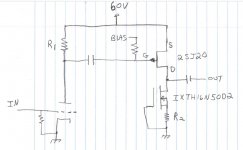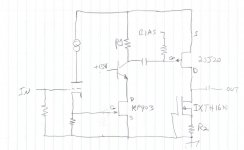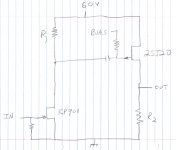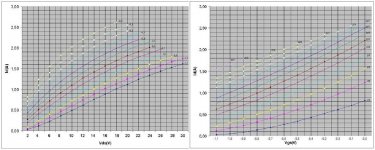Attached is a schematic of a hybrid power amp using a tube triode and a 2SJ20 SIT. The idea is inspired by the J2. I want both gain stages to be triode-esque. Both gain stages are undegenerated as a start.
What value of R1 makes for a good source resistance to drive the gate of the 2SJ20?
The exact triode to be used is undecided. I have ordered an assortment to characterize. The intent is to have enough current to drive R1 to drive the SIT rail-to-rail. Multiple tubes may have to be paralleled to obtain enough current. Curve tracing and matching tubes is no problem.
What value of R1 makes for a good source resistance to drive the gate of the 2SJ20?
The exact triode to be used is undecided. I have ordered an assortment to characterize. The intent is to have enough current to drive R1 to drive the SIT rail-to-rail. Multiple tubes may have to be paralleled to obtain enough current. Curve tracing and matching tubes is no problem.
Attachments
use source follower in between
if you want 60V rail , then 6DJ8 or 7DJ8 on input, CCS in anode to squeeze as much gain is possible
then , if you want little overall feedback , use same approach as with inverting OP - series to grid
if you want 60V rail , then 6DJ8 or 7DJ8 on input, CCS in anode to squeeze as much gain is possible
then , if you want little overall feedback , use same approach as with inverting OP - series to grid
Last edited:
With only 60V, that triode is going to be seriously voltage starved, to the point of being difficult to match performance between channels.
ZM does make a good suggestion with a current source over the anode.
ZM does make a good suggestion with a current source over the anode.
use source follower in between
if you want 60V rail , then 6DJ8 or 7DJ8 on input, CCS in anode to squeeze as much gain is possible
then , if you want little overall feedback , use same approach as with inverting OP - series to grid
The 6DJ8 looks good for this applicaiton. Thanks.
A source follower will introduce pentode current gain, yes? The initial idea is to have all of the gain stages remain triode-ish. I suppose a schade-enhanced source follower would qualify as triode-ish current gain?
With only 60V, that triode is going to be seriously voltage starved, to the point of being difficult to match performance between channels.
ZM does make a good suggestion with a current source over the anode.
Yes agreed. I look at it as the triode is un-degenerated operating wide-open the way JFETs are sometimes used.
The 6DJ8 looks good for this applicaiton. Thanks.
A source follower will introduce pentode current gain, yes? The initial idea is to have all of the gain stages remain triode-ish. I suppose a schade-enhanced source follower would qualify as triode-ish current gain?
triode will stay triode , it doesn't matter what kind of load you're going to use
however , if you prefer kosher sounding wimpy stage , use lowish rail with resistor load .......

The more sissy, the better. I will try everything. The source follower is a very good idea for current gain at that spot.
Please be aware that 2 triode stage means some characteristics imparted by the first stage will be cancelled by the second stage. You can see this by comparing FFT and residual at output of first and second stage.... A source follower will introduce pentode current gain, yes? The initial idea is to have all of the gain stages remain triode-ish. I suppose a schade-enhanced source follower would qualify as triode-ish current gain?
Please be aware that 2 triode stage means some characteristics imparted by the first stage will be cancelled by the second stage. You can see this by comparing FFT and residual at output of first and second stage.
I did not know that. Thanks for the information.
Maybe try a cathode follower instead of a source follower. There are several variations to work with, both DC and AC coupled. Being able to control the load of the first triode independently of the characteristics of the output stage devices could be very useful.
Maybe try a cathode follower instead of a source follower. There are several variations to work with, both DC and AC coupled. Being able to control the load of the first triode independently of the characteristics of the output stage devices could be very useful.
Thanks for the suggestion. It did occur to me to have a CF between the input triode and the SIT. I was hoping for simple two stage.
I received some Russian KP903 JFETs recently. Just finished measuring Idss for the lot tonight. The spread is from 160mA to 500mA. Ridiculously wide spread of Idss. It would require a massive stash of these parts to get many match pairs/quads/octets. Input capacitance is rated at 18pf. I will measure the capacitance to verify.
It occurs to me that this JFET may be interesting as the driver of the SIT. It would require cascoding for a 60V rail. Not sure about the noise floor of this JFET.
Input triode could remain as a CF.
It occurs to me that this JFET may be interesting as the driver of the SIT. It would require cascoding for a 60V rail. Not sure about the noise floor of this JFET.
Input triode could remain as a CF.
exactly opposite of SIT-1
🙂
Upside down, inverted and exactly opposite. Inspired by NP but not a copy.
I was thrilled to buy some 2SJ20 parts and find that they appear to be genuine. Just looking for a way to use them in a Pass-like fashion.
The two-transistor version should work over a wide voltage range. I will start with a low-ish voltage and work up.
The two-transistor circuit looks wonderfully simple. I suspect that a current source in place of R2 will improve performance. Maybe even a dynamic one like those discussed in the Zen V3 and Zen V4 articles, turned upside down.
Not so fast, КП901 is a first generation V-MOSFET. It might not work without bias.
http://www.quartz1.com/price/PIC/415N0263213.pdf
http://www.quartz1.com/price/PIC/415N0263213.pdf
Last edited:
I understood that above schmtcs are all simplified ones
of course that КП demands proper biasing
of course that КП demands proper biasing
- Home
- Amplifiers
- Pass Labs
- SIT-Triode Hybrid idea



